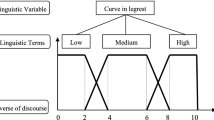Abstract
Today, producing consumer-oriented products are a key to commercial success. The successful companies have to aim to capture consumer’s psychological perception. Kansei Engineering is a type of methodology to determine consumer’s perception on product elements for using new product development. Kansei evaluation dataset were significantly developed such as uncertainty reason techniques including rough set, fuzzy set and neural networks. In literature, the rough set theory has been widely used approach to reduce the complexity of the knowledge database. In this chapter, to extract more accurate design parameters and Kansei knowledge, rough set rule based mining was applied for Kansei engineering research to baby cradle design. The proposed design methodology results show that obtained rules are consistent with customer expectations.
Access this chapter
Tax calculation will be finalised at checkout
Purchases are for personal use only
Similar content being viewed by others
References
Lu, W., Petiot, J.F.: Affective design of products using an audio-based protocol: application to eyeglass frame. Int. J. Ind. Ergon. 44(3), 383–394 (2014)
Petiot, J.F., Yannou, B.: Measuring consumer perceptions for a better comprehension, specification and assessment of product semantics. Int. J. Ind. Ergon 33(6), 507–525 (2004)
Kano, N., Seraku, N., Takahashi, F., Tsuji, S.: Attractive quality and must-be quality. J Jpn. Soc. Qual. Cont. 41, 39–48 (1984)
Cohen, L.: Quality Function Deployment: How to Make QFD Work for You. Prentice Hall (1995)
Luce, R.D., Turkey, J.W.: Simultaneous conjoint measurement: a new type of fundamental measurement. J. Math. Psych. 1(1), 1–27 (1964)
Schütte, S., Eklund, J.: Design of rocker switches for work-vehicles—an application of Kansei engineering. Appl. Ergon. 36(5), 557–567 (2005)
Nagamachi, M.: Kansei engineering: a new ergonomic consumer-oriented technology for product development. Int. J. Ind. Ergon. 15(1), 3–11 (1995)
Nagamachi, M., Tachikawa, M., Imanishi, N., Ishizawa, T., Yano, S.: A successful statistical procedure on Kansei engineering products. In: 11th QMOD Conference. Quality Management and Organizational Development Attaining Sustainability from Organizational Excellence to Sustainable Excellence; 20–22 August; 2008 in Helsingborg; Sweden (No. 033, pp. 987–995). Linköping University Electronic Press (2008)
Tama, I.P., Azlia, W., Hardiningtyas, D.: Development of customer oriented product design using Kansei engineering and Kano model: Case study of ceramic souvenir. Procedia Man. 4, 328–335 (2015)
Häfner, P., Ommeln, M., Katičić, J., Ovtcharova, J.: Immersive Kansei Engineering: A New Method and Its Potentials. Karlsruher Institut für Technologie (2018)
Lokman, A.M.: Design & emotion: the Kansei engineering methodology. Malays. J. Comp. 1(1), 1–11 (2010)
Morı, N.: Rough set approach to product design solution for the purposed Kansei. Bull. Japan. Soc. Sci. Des. 48(6), 85–94 (2002)
Nishino, T., Nagamachi, M., Sakawa, M.: Acquisition of kansei decision rules of coffee flavor using rough set method. Kansei Eng. Int. 5(4), 41–50 (2006)
Nishino, T., Satsuta, R., Uematsu, M., Sugihara, S., Nagamachi, M.: Identification of customers’ latent Kansei needs and product design by rough set based approach. In: 11th QMOD Conference. Quality Management and Organizational Development Attaining Sustainability from Organizational Excellence to Sustainable Excellence; Linköping University Electronic Press, vol. 033 Sweden, Helsingborg, pp. 341–350 (2008)
Zhou, F., Jiao, R.J., Schaefer, D., Chen, S.: Rough set based rule mining for affective design. In: DS 58-9: Proceedings of ICED 09, the 17th international conference on engineering design, vol. 9, Human Behavior in Design, Palo Alto, CA, USA, pp. 245–254 (2009)
Shieh, M.D., Yeh, Y.E., Huang, C.L.: Eliciting design knowledge from affective responses using rough sets and Kansei engineering system. J Ambient. Intell. Hum.Ized Comp. 7(1), 107–120 (2016)
Pawlak, Z.: Rough sets. Int. J. Comp. Inform. Sci. 11(5), 341–356 (1982)
Predki, B., Slowinski, R., Stefanowski, J., Susmaga, R., Wilk, S.Z.: ROSE—software implementation of the rough set theory. In: Polkowski, L., Skowron, A. (eds.) Rough design of waiting areas 407 Sets and Current Trends in Compter: Lecture Notes in Artificial Intelligence, vol. 1424, Springer, Berlin (1998)
Sabu, M.K., Raju, G.: Rule induction using Rough Set Theory—an application in agriculture. In: 2011 International Conference on Computer, Communication and Electrical Technology (ICCCET). IEEE, pp. 45–49 (2011)
Aydogan, E.K., Ozmen, M., Delice, Y.: CBR-PSO: cost-based rough particle swarm optimization approach for high-dimensional imbalanced problems. Neural Comp. App. 1–19 (2018)
Schütte, S. (2002). Designing feelings into products: integrating Kansei engineering methodology in product development. Thesis, Department Mechanical Engineering, Linkopings University, Linkoping, Sweden
Author information
Authors and Affiliations
Corresponding author
Editor information
Editors and Affiliations
Rights and permissions
Copyright information
© 2020 Springer Nature Switzerland AG
About this chapter
Cite this chapter
Akgül, E., Özmen, M., Aydoğan, E.K., Sinanoğlu, C. (2020). Baby Cradle Design with Kansei Knowledge Mining Based on Rough Set Theory. In: Kahraman, C., Cebi, S. (eds) Customer Oriented Product Design. Studies in Systems, Decision and Control, vol 279. Springer, Cham. https://doi.org/10.1007/978-3-030-42188-5_24
Download citation
DOI: https://doi.org/10.1007/978-3-030-42188-5_24
Published:
Publisher Name: Springer, Cham
Print ISBN: 978-3-030-42187-8
Online ISBN: 978-3-030-42188-5
eBook Packages: Intelligent Technologies and RoboticsIntelligent Technologies and Robotics (R0)




